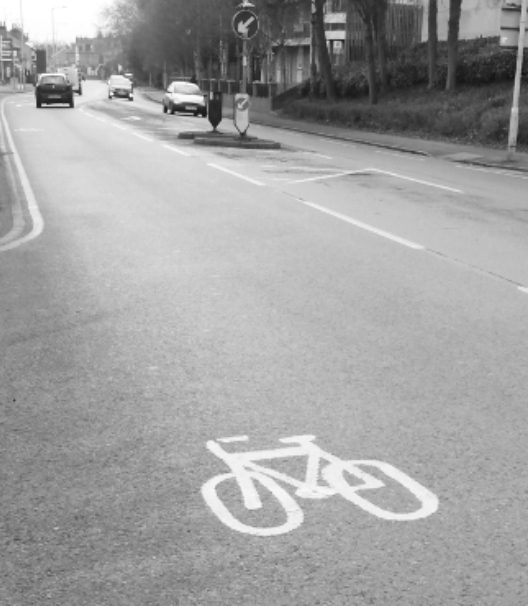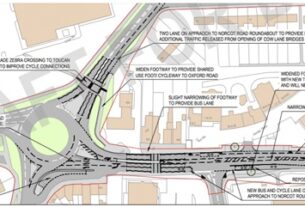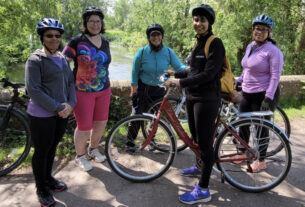Active Travel for 2021
At the end of 2020 Reading Borough Council was awarded £1.179million through the Department for Travel’s Active Travel Fund (ATF) to support the implementation of walking and cycling schemes in the borough.
This award is the second tranche of funding from the ATF; the first tranche funded the ‘pop-up’ schemes that were introduced in response to the onset of the COVID pandemic last year. For the sake of speed, the Tranche 1 schemes were introduced without consultation.
In contrast, Tranche 2 schemes are intended to be designed with more deliberation – consequently one of the conditions of the funding is that Local Authorities undertake consultation.
RBC has set out plans for consultation on the Tranche 2 schemes to be undertaken in two phases. According to the Council, the first phase will be to provide the opportunity to raise awareness of the scheme proposals and collect feedback on the schemes in principle.
The second phase of consultation will follow analysis and feedback from Phase 1, and will present more detail on the specific design and traffic management aspects of the proposed schemes and offer greater clarity around the planned timeframe for scheme commencement and completion.
The Council has also stated that Phase 2 will include further workshops with key stakeholders to consider the emerging scheme designs and provide opportunities for comment prior to moving into the detailed design stage.
Reading Cycle Campaign has been calling for engagement with the Council for some time, so this consultation is welcome. However, beyond every rock there is a hard place and the challenge for RBC will be to progress Tranche 2 active travel schemes that are well designed and supported, but without undue bureaucracy and delay.
The Department for Transport’s timetable is for new schemes to be in place ‘soon after the start of the new financial year’ – to meet that target the Council will need to get its skates on.
RBC’s bid for Tranche 2 funding from the Active Travel Fund linked to the following five proposed schemes (details from RBC website):
Southampton Street and Oracle Roundabout (Pell Street – Inner Distribution Road/Bridge Street)
Create a segregated cycle lane along Southampton Street, with changes at the junctions at either end, linking with existing cycle infrastructure through the reallocation of road space from general traffic.
A key ‘missing link’ in the existing network, it will provide a continuous link between existing routes including NCN Routes 4 and 422.
Bath Road/Castle Hill (Southcote Lane – Inner Distribution Road/Castle Street)
Running from the IDR to Russell Street, reallocate road space from general traffic to create a segregated lane for cyclists to and from the town centre.
A further ‘missing link’ on the existing network. An additional scheme (Russell Street – Southcote Lane) if funding allows, would extend the route west, linking with the new NCN route 422 and connecting with existing routes west of the railway bridge. Both cyclists and pedestrians will benefit from the physically segregated route.
Shinfield Road (Christchurch Green – Whitley Wood Road)
Create a segregated two-way cycle lane, linking to the Phase One schemes on Redlands Road and Christchurch Road. A high-quality facility on a key route between South Reading and Royal Berkshire Hospital, the University of Reading, local centres and Reading town centre.
London Road (Borough boundary to Cemetery Junction)
Reallocate road space from general traffic to create an inbound shared bus and cycle lane. This will provide a key missing link with the shared bus and cycle route being implemented in Phase One on London Road outside of the RBH.
Forbury Road / Vastern Road (Watlington Street – Reading Bridge)
Create a segregated two-way cycle lane by reallocating road space from general traffic on this section of the IDR. This will also provide further separation for pedestrians through lower volumes of cyclists using the existing shared pavement.
The £1.2million of active travel funding is not sufficient to allow all the above schemes to be progressed and as such a decision will need to be made as to which to take forward using the funding received. Early indications are that the Council favours the schemes for Southampton Street and Castle Hill.
Perhaps by the time you read this the formal consultation, process will have begun. We will let you know by posting details on our Facebook page and website.
Active Travel – Changing Gear
For years cycle campaigners have been pleading with Local Transport Authorities to put a bit of white paint on some of our busiest roads in order to encourage more cycling. We were thankful when a few proverbial crumbs fell off the transport table to help nourish a healthier, safer, less polluting and more sustainable transport system.
 It takes a few decades for mindsets to change – some of those fringe environmental ideas from the second half of the 20th century that were the preserve of ‘hippies’ are now government policy. It does now seem that mindsets are starting to change on cycle infrastructure.
It takes a few decades for mindsets to change – some of those fringe environmental ideas from the second half of the 20th century that were the preserve of ‘hippies’ are now government policy. It does now seem that mindsets are starting to change on cycle infrastructure.
In the last few months, we have seen a proliferation of white painted cycle symbols peppered across the middle of Reading’s roads, but the world has moved on, and the concept of good cycle infrastructure is no longer a painted cycle symbol or a white line.
The latest government policy on cycling is contained in the 2020 document ‘Gear Change: a bold vision for cycling and walking’. This outlines a break from previous ideas of what cycle infrastructure should look like:
“Cycle tracks can be separated from traffic using a kerb, or lighter touch materials … but they must be physically separated, not just on the stretches between junctions, but at junctions themselves, the places of greatest danger for cyclists … cycle route provision on busy roads which consists of painted markings or cycle symbols will no longer be funded.”
“Cycles must be treated as vehicles and not as pedestrians. On urban streets cyclists should not share space with pedestrians.”
Although it is local authorities that design and install cycle infrastructure what central government thinks matters, as more often than not local authorities create the cycle infra-structure using central government funds that have to be bid for.
With regard to the current Active Travel Fund allocations the Department for Transport wrote to all Councils stating that all cycling schemes, permanent or temporary, will need to include segregation or point closures to through traffic: advisory cycle lanes, and those marked only with white paint, will not be funded.
So local authorities will need to widen their cycle infrastructure palette to include more than just white paint.
Reading’s Local Transport Strategy
It is well known that in February 2019 the Council set a target for the town to be carbon neutral by 2030. Two years in we ask what progress has been made in the field of transport?
Reading’s Transport Strategy to 2036 was issued as draft for consultation in May 2020. This set out a bold vision for transforming transport in Reading and was due to be adopted in December 2020, but at the time of writing in January this has not yet happened.
At the beginning of 2021 we are waiting to see this strategy get off the ground.
Keith Elliott
RCC Secretary



In my view the cycle lanes on the northern approach to Reading Bridge are misconceived. I think they were part of the rush-job Tranche 1. Money would have been better spent getting cyclists off this narrow, busy road, which leads to the notoriously dangerous roundabout at the junction with Vastern Road near the railway bridge. Instead of giving us a lane on a busy road, it would have been better to provide a cycle track across Christchurch Meadows leading to Christchurch Bridge. Was something better than nothing in this case? Personally I doubt it. This kind of scheme encourages the idea that any bike provision is good if it can be whacked into place cheaply. I haven’t sent a copy of this comment to the Council because I don’t know if the Cycle Campaign will agree. If you do agree, do pass it on to the Council.
Sorry but I would totally disagree. I dont want to go on the narrow Christchurch bridge, which has no segregation between cyclists and pedestrians and is too narrow for two way traffic of both. I dont want to then negotiate the awkward towpath etc. This footbridge was never designed for cyclists, despite what the council said and is not appropriate at all – either the bridge or the approaches on either side.
I and most other cyclists continued to use Reading bridge because it was the best and most practical route. The extra cycle lanes here are possibly the only good bit of cycling infrastructure I can think of in the entirety of Reading. They stopped the problem of motorists trying to overtake over the crest of the bridge in a Northerly direction, only to find another coming South in the middle lane, which made them then swerve back into the single Northbound lane regardless of whether they would wipe out a cyclist in the process…!
I agree about the roundabout though – having been knocked off by a careless taxi driver and spending months off work with various operations and rehabilitation etc.
I used to live on the Shinfield Road and cycled along it almost daily. I heartily support your proposal for a two-way cycle lane there. The road is relatively lightly trafficked by motor vehicles, and fairly wide, which means they tend to go fast. Pedestrians are few, and on-street parking non-existent. As you say, this is a key artery for cyclists.
I disapprove of scattered cycle symbols painted on roads. It would be far better for the symbol to be used only on space which is dedicated to cyclists. Scattered symbols, meaning ‘you might find a cyclist here’, confuse the message when a the same symbol on a cycle lane, or at a forward stop line at traffic lights, means CYCLISTS ONLY MOTORISTS KEEP OUT. I’m a motorist too and I believe that randomly placed cycle symbols are simply distracting and confusing to motorists.